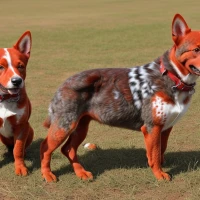Unleash the True Spirit of Down Under with Our Ultimate Australian Shepherd Breed Guide! Dive into a world where loyalty meets agility, and discover the kaleidoscope of traits that define this captivating breed. Whether you’re a seasoned owner or considering your first furry companion, our comprehensive care tips, adorable photos, and insightful observations will help you decode every bark and tail wag of your Aussie pal. Embrace the Aussie adventure—your guide to mastering life with an Australian Shepherd starts now!
Breed Overview

Australian Shepherds, often known as “Aussies,” are a breed that embodies agility, intelligence, and energy. They were originally bred in the United States to herd livestock and are still used by many as working dogs. Despite their name, the breed doesn’t have its origins in Australia but was developed on ranches in the western United States during the 19th century.
Breed Traits:
- Intelligence: Australian Shepherds are incredibly smart, making them highly trainable for various tasks, including herding, obedience, and agility competitions.
- Energy: They are high-energy dogs that require plenty of exercises. Without it, they can become bored and develop behavior issues.
- Herding Instinct: They have a strong herding instinct, which can sometimes extend to small children and other pets. It’s crucial for owners to channel this instinct effectively.
- Appearance: They typically have a medium-length coat with colors varying from blue merle, black, red merle, to red—all with or without white markings and/or tan (copper) points.
- Size: Aussies are medium-sized dogs with males usually larger than females. They stand about 18-23 inches at the shoulder.
Care Tips:
- Exercise: A daily regimen of vigorous exercise is crucial. This might include long walks, runs, or dog sports.
- Mental Stimulation: Their intelligence means they thrive on mental challenges. Puzzle toys, training, and regular interaction are very beneficial.
- Grooming: Regular brushing is required to manage their thick coats, especially during shedding seasons. They may need occasional baths but be wary of overbathing, which can strip natural oils.
- Training: Start training early. Positive reinforcement methods work well with this breed.
- Socialization: It’s important to expose them to different people, dogs, and situations early on to foster a well-adjusted temperament.
Health Insights:
- Lifespan: They generally live for about 12-15 years.
- Common Health Issues: Like many purebred dogs, they can be prone to specific health problems such as hip dysplasia, epilepsy, and certain eye conditions.
- Diet: A diet rich in nutrients suitable for high-energy breeds is optimal. Be mindful of their caloric intake as they can become overweight if not exercised enough.
Photos & Visual Characteristics:
Australian Shepherds are visually stunning due to their striking fur patterns and eye colors, which can range from blue to brown, and even include heterochromia (two different colored eyes). They possess a sturdy build, with a straight to slightly wavy coat that provides insulation and protection. Photos often capture their alert and ready-to-work demeanor, which is characteristic of the breed.
Owning an Aussie can be a rewarding experience for active individuals or families who have the time and energy to invest in their pet’s physical and mental needs. With consistent care, an Australian Shepherd can be a loyal, loving, and exuberant companion.
Australian Shepherd Characteristics

The Australian Shepherd, often known as an “Aussie,” is a highly energetic and intelligent breed, which makes them a popular choice for many dog enthusiasts. This breed has a striking appearance, often characterized by their beautiful merle coat patterns and bright, attentive eyes, which can be blue, brown, amber, or a mix of these colors.
Characteristics:
-
Intelligence: Australian Shepherds are known for their sharp intellect. They are quick learners and excel in obedience training. Their intelligence makes them ideal working dogs, and they often do well in agility and other dog sports.
-
Energy: This breed has high energy levels and requires plenty of exercises to remain healthy and content. They thrive on activities that keep them engaged both mentally and physically. Without proper exercise, an Aussie might resort to undesirable behaviors out of boredom.
-
Herding Instinct: Bred originally for herding livestock, Australian Shepherds have a strong instinct to herd. This can sometimes manifest as a tendency to herd children and other pets. Early training can ensure this behavior doesn’t become problematic.
-
Temperament: Aussies are generally friendly and good-natured. They tend to be loyal and affectionate with their families and can be reserved with strangers. Socialization from a young age is crucial to ensure they’re well-adjusted and confident.
-
Size and Build: They are medium-sized dogs with a muscular build that showcases their agility and strength. Males typically weigh between 50-65 pounds, while females are slightly smaller, ranging from 40-55 pounds.
-
Coat and Grooming: The breed has a medium-length, water-resistant coat that comes in several colors including blue merle, red merle, black, and red—often with white and/or tan markings. Their double coat requires regular grooming to keep shedding under control and to prevent matting.
Care Tips:
-
Exercise: Australian Shepherds need at least one to two hours of exercise per day. Activities could include brisk walking, running, fetch, and participation in canine sports.
-
Mental Stimulation: Puzzle toys, advanced obedience training, and consistent learning opportunities are essential to keep an Aussie’s mind active.
-
Grooming: Regular brushing several times a week is necessary to maintain their coat’s health, in addition to standard care like nail trimming and teeth cleaning.
-
Diet: A balanced diet tailored to their activity level will help keep your Aussie in tip-top condition. High-quality dog food with sufficient protein is recommended.
-
Health Monitoring: Regular veterinary check-ups are vital. Australian Shepherds can be prone to certain hereditary health issues such as hip dysplasia, epilepsy, and vision problems.
-
Training and Socialization: Begin training early and use positive reinforcement techniques. Socialization with people and other animals is essential to prevent any territorial or aggressive behaviors.
Photos & Insights:
Photographs of Australian Shepherds typically capture their vibrant eyes and plush coats. They are often seen in active poses, highlighting their agility and athleticism. Insightful moments can be found when they’re at work herding or competing in agility courses, where their focus and determination shine through.
To truly appreciate the full charm of the Australian Shepherd, one must witness their interaction with their environment. They are at their happiest when they have a job to do or are engaging in interactive play with their human companions. Their presence is one of active joy, and it’s clear they form a strong, spirited bond with those who care for them.
In summary, the Australian Shepherd is a dedicated and versatile breed that makes an excellent companion for active individuals or families. Attention to their physical and mental needs, along with responsible breeding and care practices, will ensure these intelligent and beautiful dogs live happy, fulfilling lives.
Australian Shepherd Puppies

The Australian Shepherd is a highly intelligent and energetic breed, famously known for its versatility and loyalty. Although the name suggests an Australian origin, these dogs were actually developed in the United States. Australian Shepherds, or “Aussies,” are easily recognizable by their thick multicolored coats and bright, expressive eyes, which can be blue, brown, or a variation of both.
Traits:
Australian Shepherds belong to the herding group and were initially bred to herd livestock. This purpose had a significant influence on their physical and behavioral traits. They are medium-sized dogs, with males typically weighing between 50-65 pounds and females between 40-55 pounds. Their coats can vary widely in color, with some common patterns being blue merle, black, red merle, and red with white and tan markings.
Aussies are known for their intelligence and eagerness to please, which makes them highly trainable. They possess an abundant amount of energy and require plenty of physical exercise and mental stimulation. Without proper outlets for their energy, they may develop undesirable habits such as excessive chewing or barking.
Care Tips:
- Exercise: Give your Aussie at least 1-2 hours of exercise per day, which can include walks, runs, hikes, or agility training.
- Mental Stimulation: Keep their minds active with training sessions, puzzle toys, and games like fetch or herding balls.
- Grooming: Their thick double coat requires regular brushing, several times per week, to prevent matting and to manage shedding.
- Health Care: Schedule regular vet check-ups, maintain up-to-date vaccinations, and keep an eye on common breed health issues like hip dysplasia and certain eye conditions.
- Training: Start obedience training early and use positive reinforcement techniques. Aussies are keen learners and adept at dog sports.
- Socialization: Expose them to various people, animals, and settings early on to ensure they develop into well-rounded dogs.
Photos & Insights:
Photos of Australian Shepherds often capture their agility in motion, the variety in their coat patterns, and their attentive expressions. When browsing through images, you’ll also likely notice their signature alert stance and the intensity of their gaze, which speaks to their acute focus and intelligence.
Owners frequently report that Aussies form strong bonds with their families and are protective of their household. They may be reserved around strangers at first, but once they warm up, they make affectionate and loyal companions. The breed’s herding background means they might try to herd children and other pets, a behavior that should be managed with proper training.
For prospective Australian Shepherd owners, it’s essential to understand the commitment involved in raising a puppy. They require a lot of attention, guidance, and activity. Australian Shepherd puppies, with their fluffy coats and adorably oversized paws, are particularly irresistible. It’s crucial to begin training and socialization early to ensure they grow into well-behaved adult dogs.
In conclusion, the Australian Shepherd is a fantastic breed for active individuals or families who can meet their needs for exercise, mental engagement, and companionship. With the right care and training, an Aussie can be a delightful addition to one’s life, offering endless joy, companionship, and wonder through their spirited nature and deep loyalty.
Temperament & Intelligence of the Australian Shepherd
Australian Shepherds are known for their remarkable intelligence and adaptable temperament. They are working dogs with a rich heritage in herding livestock, which has equipped them with an impressive level of problem-solving skills and a strong work ethic. These dogs require regular mental stimulation and enjoy tasks that challenge their brain, making them excellent candidates for obedience, agility, and other dog sports.
The intelligence of an Australian Shepherd is not limited to following commands; these dogs are quick learners that can perform complex tasks and make decisions independently. This makes them an excellent companion for active individuals or families who can provide them with the necessary engagement and exercise. However, this intelligence also means that they can become bored and destructive if they are not given enough to do.
Their temperament is characterized by their loyalty and protective nature. Australian Shepherds form strong bonds with their owners and are often wary of strangers, making them good watchdogs. However, they need to be socialized from an early age to ensure that their protectiveness does not turn into aggressiveness.
The breed is also known for its high energy levels. They thrive on having a job to do and will often become restless if they are unable to expend energy through physical activity or mental challenge. As such, Australian Shepherds are best suited to homes with ample space and an active lifestyle.
When it comes to care, Australian Shepherds have a double coat that requires regular maintenance. Brushing a few times a week and the occasional bath will help to manage shedding and keep their coat healthy. Ears should be checked regularly for signs of infection, and their teeth should be brushed frequently.
It is also important to focus on their diet and exercise regimen. Due to their active nature, Australian Shepherds require a well-balanced diet that supports their energy levels. Proper nutrition will also prevent common health issues such as obesity, which can lead to more serious complications in active breeds like the Australian Shepherd.
In terms of health, they are generally a healthy breed but can be predisposed to certain genetic conditions like hip dysplasia, epilepsy, and certain eye disorders; therefore, regular vet check-ups are advisable.
Australian Shepherds are wonderful companions for those who understand and can meet their needs for exercise, mental stimulation, and companionship. These dogs can bring a lot of joy and activity to a household and are highly trainable partners for various canine sports and service work.
To illustrate the breed, photos usually depict the Australian Shepherd in action—herding, playing fetch, or demonstrating agility. They are medium-sized dogs with a recognizable coat pattern, often in merle, red, and tricolor variations. Their expressive eyes can come in different colors, like blue or brown, adding to their striking appearance.
Are These Dogs Good for Families?👪

Australian Shepherds are a popular breed known for their intelligence, versatility, and high energy levels. They are often described as loyal, affectionate, and eager to please, making them excellent companions for active families who can provide them with the mental stimulation and physical exercise they need.
Traits:
- Intelligence: Ranked as one of the most intelligent dog breeds, Australian Shepherds are quick learners and often excel in obedience training.
- Energy: They have a lot of stamina and require regular exercise to maintain their health and happiness. They are well-suited to active families or individuals who enjoy outdoor activities.
- Herding Instinct: Originally bred for herding livestock, they may exhibit herding behavior such as gently nipping or trying to herd children or other pets.
- Appearance: They have a striking appearance with a medium-length coat that can come in a variety of colors, including blue merle, red merle, black, and red tri-color.
Care Tips:
- Exercise: Plan for at least 1-2 hours of exercise daily. Activities can include walks, runs, hikes, dog sports, and interactive play sessions.
- Training: Enroll in obedience classes. Positive reinforcement methods work well with this breed.
- Grooming: Their double coat requires regular brushing to prevent matting and reduce shedding. During the shedding season, more frequent grooming is needed.
- Socialization: Expose them to different environments, people, and other animals to ensure they are well-adjusted and sociable.
Are These Dogs Good for Families? 👪 Australian Shepherds can be wonderful family dogs if the family is prepared for the high level of commitment required to meet their needs. They thrive in environments where they can be part of the family’s daily activities. However, due to their herding instincts, they may try to herd small children, which can be managed with proper training and supervision.
For families with small children or less active lifestyles, the high energy level and herding tendencies of an Australian Shepherd may be challenging. It’s important for potential owners to realistically assess their ability to provide the necessary exercise, training, and attention.
Fortunately, Australian Shepherds are known for their adaptability and can fit well into various living situations, including those with children, as long as they are given the appropriate outlets for their energy and intelligence.
Photos & Insights:
- Photos of Australian Shepherds typically showcase their expressive eyes and beautiful, multi-colored coats.
- Sharing insights from Australian Shepherd owners can provide a more in-depth understanding of living with the breed. Many owners find that these dogs are an integral part of the family, participating in all aspects of home life. Owners often express the joys of having a smart, trainable, and enthusiastic companion, while also noting the importance of staying ahead of their high energy and potential for mischief without proper exercise and mental engagement.
Considering these aspects, Australian Shepherds can certainly be a great addition to the right family. With proper care, training, and love, they often form strong bonds and provide years of companionship and joy.
Does This Breed Get Along With Other Pets?

Australian Shepherds, commonly known as Aussies, are a herding breed known for their intelligence, agility, and active lifestyle. This breed typically exhibits traits such as high energy, loyalty, and a friendly disposition. As working dogs, they have a strong herd instinct and may sometimes try to herd other pets or even their human family members. This natural instinct, combined with their playful nature, often means that they can get along with other pets if properly socialized and trained.
However, when it comes to interactions with other animals, there are a few things to consider:
-
Early Socialization: It’s crucial to introduce an Aussie to various pets, environments, and people at a young age to foster good behavior and comfort around others.
-
Training: Consistent, positive reinforcement training can help manage herding behavior, making it easier for Aussies to get along with other pets.
-
Exercise: Aussies require ample exercise to manage their energy levels. Without sufficient exercise, they may exhibit undesirable behaviors toward other pets, such as excessive herding or chasing.
-
Supervision: Always supervise initial encounters between your Aussie and other pets. Pay attention to body language and signs of discomfort or aggression.
-
Compatibility: Consider the temperament of both the Aussie and the other pet. Some animals may be a better match for the outgoing and energetic nature of an Australian Shepherd.
With proper training and socialization, Australian Shepherds can coexist peacefully and even form strong bonds with other pets. They are especially good with other dogs and animals that match their energy level and with whom they can engage in play and exercise.
Caring for an Australian Shepherd also includes regular brushing since they have a double coat that sheds year-round and more heavily during seasonal changes. Additionally, given their high energy levels, they require regular exercise, mental stimulation, and a nutritious diet to keep them fit and healthy.
Photographs of Australian Shepherds often capture their striking eyes, which can be blue, brown, or even mismatched, as well as their beautiful merle, red, or black-and-white coats. They are medium-sized dogs with a robust build, emanating a strong and agile presence.
Gaining insights into the traits and care for an Aussie will ensure that they lead a fulfilled and happy life, and can become loving companions that will enrich your life. Remember that each Australian Shepherd has a unique personality, so individual dogs may vary in their compatibility with other pets.
Things to Know When Owning an Aussie

Australian Shepherds, affectionately known as Aussies, are a vibrant, active breed beloved for their intelligence and herding prowess. They are medium-sized, robust, and well-balanced dogs possessing both agility and stamina. Here’s what every potential Aussie owner should know:
Traits:
- High Energy and Intelligence: Aussies are incredibly smart and have an abundance of energy, requiring both mental and physical stimulation.
- Herding Instincts: Independently smart, Aussies might try to herd children or other pets.
- Loyalty: These dogs form strong bonds with their families and can be quite protective.
- Color Variations: Their coats come in blue merle, red merle, black, red, all with or without white markings and/or tan points.
- Coat Maintenance: The breed has a beautiful, thick double coat that sheds and requires regular grooming.
- Eye color variety: Aussies have distinctive eyes that can be blue, brown, amber, or even a combination of these.
Care Tips:
- Training: Start early with obedience training. Positive reinforcement methods work best with Aussies due to their intelligence and sensitivity.
- Exercise: They need plenty of vigorous exercises every day. Without it, they may develop behavioral issues.
- Diet: Feed high-quality food to match their energy needs. Be mindful of portion sizes to prevent obesity.
- Mental Stimulation: Provide puzzle toys, advanced training, and regular interaction to keep their minds sharp.
- Socialization: Expose them to different people, dogs, and situations to prevent shyness or aggressiveness.
- Health Checks: Regular vet visits are crucial to check for hip dysplasia, epilepsy, and other common hereditary health issues in Aussies.
Photos & Insights: Aussies are visually stunning, and their photos often showcase their bright, clear eyes and a tendency to be in motion. Many pictures will capture Aussies at work or play, highlighting their versatility and athleticism.
In terms of insights, owners often share that despite the breed’s boundless energy, Aussies can be Couch Potatoes at times, given the right amount of exercise. Their intelligence makes them highly trainable, and they excel in dog sports such as agility, obedience, and herding trials. New potential owners should be aware that the Aussie’s drive and smarts mean they are not the kind of dog to be satisfied with a sedentary lifestyle or being left alone for long periods.
In summary, the Australian Shepherd is a terrific companion for the right person or family. They fit best with active lifestyles, those who enjoy outdoor pursuits, or have a job for the dog to do (like agility and other dog sports). Remember, their intelligence and intensity demand time and dedication, but also offer immense rewards in companionship.
Food & Diet Requirements🦴

Australian Shepherds, often referred to as “Aussies,” are a medium-sized breed of dogs known for their intelligence, agility, and loyalty. They are a herding breed originally bred to work on ranches, which means they have high energy levels and require a well-balanced diet to keep them healthy and active. Here’s a guide to the food and diet requirements of Australian Shepherds.
Traits:
- Active Lifestyle: Aussies are very active and need plenty of exercise. Their diet should support their high energy needs.
- Intelligent: They are highly intelligent, which can sometimes translate to being picky eaters. Engaging them with food puzzles can help stimulate their brains and make mealtime more interesting.
- Growing Puppies: Aussie puppies have specific nutritional needs to support their rapid growth and development.
Food & Diet Requirements:
- High-Quality Protein: Look for foods that list real meat as the first ingredient. Proteins are crucial for muscle development and repair.
- Balanced Omega Fatty Acids: Omega-3 and Omega-6 fatty acids are important for skin and coat health, particularly for Aussies, who have a thick, double layer coat.
- Adequate Calories: Given their activity level, Australian Shepherds need a calorie-dense diet, especially working dogs that herd and compete in dog sports.
- Age-Appropriate Food: Puppies, adults, and seniors all have different dietary needs. Puppies need food high in calories and nutrients to support growth, adults need balanced maintenance diets, and seniors may require fewer calories and more joint support ingredients.
- Limited Fillers: Avoid foods with excessive fillers like corn, wheat, and soy, which offer less nutritional value and may lead to overeating.
Care Tips:
- Regular Feeding Schedule: Consistency in feeding times and amounts helps maintain an Aussie’s metabolism and energy levels.
- Monitor Weight: Due to their high energy, Aussies may seem like they can eat a great deal without gaining weight. However, it’s important to monitor their diet to prevent obesity, which can put stress on their joints.
- Stay Hydrated: Ample fresh water should always be available, especially if your Aussie is active outdoors.
- Consider Allergies: Aussies can be prone to food allergies. Watch for signs of allergies such as itching and gastrointestinal upset and consult with a veterinarian if these arise.
Photos & Insights: When looking to adopt or buy an Australian Shepherd, photos can provide insights into the breed’s physical traits such as their coat colors (blue merle, red merle, black, red, with varying amounts of white and/or tan markings) and their expressive eyes, which can be blue, brown, or amber. Photo references also showcase Aussies in action, highlighting their agility and strength.
Please Note: Before making any significant changes to your Australian Shepherd’s diet, or if you have concerns about their nutrition, it is always best to consult with a professional veterinarian. Aussies, like any other breed, may have individual needs based on their health, age, and level of activity, which a vet can help you to address.
Exercise🐕

Australian Shepherds, also known as Aussies, are a herding breed known for their intelligence, agility, and energetic disposition. They have a rich history as working dogs on ranches and farms, which has cultivated their need for regular exercise and mental stimulation. Below are aspects of their traits, care tips, including exercise requirements, as well as additional insights.
Traits
Australian Shepherds are medium-sized dogs, with males typically ranging from 20 to 23 inches tall at the shoulder and females slightly smaller at 18 to 21 inches. They possess a mix of colorful coat patterns, including blue merle, red merle, black, and red, often with white markings and tan points. Aussies are well-balanced and agile, with bobbed tails being a common trait. Their double coats are weather-resistant, which makes them suitable for various climates, and they have strong, muscular builds.
Exercise🐕
Exercise is paramount for the wellbeing of an Australian Shepherd. They require significant physical activity daily – ideally more than two hours. Consider the following exercise tips:
-
Regular Walks: Long walks or jogs can significantly benefit their physical and mental health. Keeping them on a leash is recommended unless they are in a secure, open space.
-
Dog Sports: Activities like agility courses, herding trials, flyball, and disc competitions are excellent ways to channel their energy and cater to their working dog instincts.
-
Interactive Play: Interactive games such as fetch, frisbee, and tug-of-war can help them burn energy and build a bond with their owners.
-
Training Sessions: Incorporating training into exercise routines keeps their mind active. Obedience, tricks, and puzzle solving are suitable exercises for mental stimulation.
-
Swimming: Many Australian Shepherds enjoy water and swimming can be a great alternative exercise, especially in warm weather.
-
Hiking: They make excellent hiking companions, given their stamina and love for the outdoors.
Care Tips
- Grooming: Regular brushing is needed to keep their coat free of mats and debris, and to manage shedding.
- Health: Routine veterinary check-ups are important. Aussies can be prone to certain genetic health issues, so it’s vital to work with a reputable breeder if you’re getting a puppy.
- Diet: Feed them a balanced diet suited to their age, size, and activity level.
- Socialization: Early and ongoing socialization helps Australian Shepherds become well-rounded dogs.
- Mental Stimulation: This breed craves mental engagement. Training, learning tricks, and interactive toys can help keep their minds sharp.
Photos & Insights
Australian Shepherd photos typically show highly alert and bright-eyed dogs with richly patterned coats. Looking at a gallery of Aussie photos will reveal their striking, varied eye colors, which can include blue, brown, hazel, or even two different colors (heterochromia).
Insights from Australian Shepherd owners stress the importance of committing time to train and exercise these bright dogs. They share that Aussies form deep bonds with their families and can be protective. Additionally, they may try to herd children and other pets due to their strong herding instincts. Some owners also note that Aussies can be reserved with strangers and require proper socialization to ensure they’re comfortable in various situations.
Australian Shepherds make excellent companions for active individuals and families who have the time to invest in their extensive exercise and mental stimulation needs. With proper care and attention, Aussies are loyal, loving pets that bring a lot of joy and activity to a home.
Training🎾

Australian Shepherds, lovingly known as “Aussies,” are energetic, intelligent, and hardworking dogs originally bred on American ranches. Here’s a guide to the essential traits and care tips, along with some insights and photos to help you understand this breed better.
Traits of Australian Shepherds:
- Intelligence: Highly intelligent and quick to learn new commands.
- Energy Level: Energetic and requires plenty of exercises.
- Herding Instinct: Natural herders, often seen trying to herd animals and even people.
- Physicality: Medium-sized with a strong, muscular build, featuring a medium-length coat.
- Coat Colors: Various, including blue merle, red merle, black, and red, often with white and/or tan markings.
- Eye Colors: They can have blue, brown, hazel, or even two different colored eyes.
When it comes to photos of Australian Shepherds, they often showcase their agility, their beautiful coat patterns, and their striking, expressive eyes. A snapshot of an Aussie in action, whether catching a Frisbee, maneuvering through agility courses or running through open fields, can truly depict the breed’s vivacious and athletic nature.
Training Australian Shepherds: Training and properly socializing an Australian Shepherd are crucial to harness their energy and prevent the development of problematic behaviors. As their main keyword suggests, they are receptive to training which should be:
- Consistent: Establish a routine and stick to it.
- Positive Reinforcement: Use treats, praises, and play to reward good behavior.
- Mental Stimulation: Challenge their intellect with puzzle toys and new tricks.
- Early Socialization: Expose them to different people, pets, and environments early on.
- Exercise: Sufficient daily exercise to manage their energy levels. Training them in dog sports like agility, disc games, and flyball can be very beneficial for their physical and mental well-being.
Care Tips:
- Grooming: Their coat needs regular brushing to prevent mats and to manage shedding.
- Diet and Nutrition: Maintain a well-balanced diet suited to their age, size, and activity level.
- Health Checkups: Regular veterinary visits for vaccinations and to screen for common breed-specific health issues like hip dysplasia, epilepsy, and certain eye conditions.
- Love and Affection: Aussies are very loyal and thrive on companionship. They do best with active families where they can be involved in daily activities.
Insights: Owners should also be aware that Australian Shepherds can become destructive if bored or left alone for extended periods. It’s important to invest time in their training and care to keep them mentally and physically healthy.
Australian Shepherds make fantastic companions for those who lead an active lifestyle and are willing to integrate them fully into family activities. Their abilities truly come to life when they have a job to do, be it competing in sports, working on a farm, or participating in search and rescue operations.
In conclusion, Australian Shepherds are a delightful but demanding breed, best suited to active owners who have the time and energy to invest in proper training and care. Their loyalty, intelligence, and energy make them a rewarding, albeit challenging, addition to the right family.
For those considering bringing an Aussie into their home, it’s recommended to connect with established breeders or rescue organizations, ensuring they provide plenty of information on the individual dog’s history and needs. This ensures a good match between the dog and its prospective family and a happier, healthier life for these beautiful and capable canines.
Grooming✂️

Australian Shepherds, affectionately known as Aussies, are a medium-sized breed of dog known for their intelligence, energy, and striking appearance. These dogs make loyal companions and require specific care to maintain their health and happiness.
Traits: Aussies are characterized by their beautiful, striking coat which comes in a variety of colors, including blue merle, red merle, black, and red, often with white and tan markings. They typically have a lifespan of around 12-15 years and are known for their agility, intelligence, and herding abilities. This breed makes excellent family pets and are good with children, but because of their herding instinct, they might try to herd small children or other pets.
Grooming: To maintain an Aussie’s coat in top condition, regular grooming is essential. Their double coats protect them from various weather conditions, but it can also mat and tangle without proper care. Here are some grooming tips:
- Brush Regularly: Weekly brushing is necessary to remove loose fur and prevent matting. During shedding season, which occurs twice a year, more frequent brushing may be required.
- Use the Right Tools: A slicker brush, undercoat rake, and dematting tool should be part of your grooming kit. These tools can help you manage their thick undercoat and prevent tangles.
- Bathing: Aussies don’t need frequent baths, but they should be bathed when necessary. Use a dog-formulated shampoo to protect their skin and coat’s natural oils.
- Nail Trimming: Regular nail trimming is important to avoid overgrowth, splitting, and cracking. Keep their nails at a length where they don’t touch the ground when standing.
- Ear Check: Aussies have floppy ears that can trap moisture and debris, leading to infections. Clean their ears regularly and check for signs of irritation or infection.
- Dental Care: Brush their teeth regularly with dog-specific toothpaste to maintain good dental health and prevent tartar buildup.
Physical and Mental Exercise: Aussies have high energy levels and require plenty of exercise to stay healthy and prevent destructive behavior due to boredom. They excel in dog sports such as agility, flyball, and obedience. Mental stimulation is also vital; puzzle toys, training sessions, and interactive play will help keep their minds sharp.
Diet and Nutrition: Feed your Aussie high-quality dog food appropriate for their age, size, and activity level. Monitor their food intake and weight to prevent obesity, which can lead to health issues. Always provide fresh water and consult with your vet about any dietary concerns.
Health: Some common health issues in Australian Shepherds include hip dysplasia, epilepsy, and hereditary eye disorders. Regular veterinary check-ups and vaccinations are important for early detection and management of any potential health problems.
Insights: Owning an Aussie requires commitment, but their companionship is incredibly rewarding. Understanding and meeting their needs for exercise, mental stimulation, and companionship will result in a happy, healthy, and well-adjusted dog.
Photos: Visual references are vital for a comprehensive guide. Ideally, you should include high-quality photographs that showcase Aussies in various settings: close-ups of their coat patterns, images of them being groomed, engaging in exercise, or pictures highlighting their herding abilities. Such photos can illustrate the breed’s beauty and versatility, while also providing owners with a clearer understanding of what to expect.
In summary, the Australian Shepherd is a vibrant, dynamic breed that thrives with attentive grooming, sufficient exercise, and a loving environment. One of the key factors to raising a happy and content Aussie is understanding their grooming needs to keep their gorgeous coats looking their best.
Health and Conditions🏥

The Australian Shepherd, often known as the “Aussie,” is a highly intelligent and energetic breed known for its agility, trainability, and friendly demeanor. This breed requires both physical exercise and mental stimulation to maintain its well-being. Here’s a guide to understanding their traits, care tips, and health conditions that might affect them.
Traits:
- Size & Appearance: Australian Shepherds are medium-sized dogs, with males typically weighing between 50-65 pounds and females 40-55 pounds. They feature a striking coat that can be blue merle, red merle, black, or red, often with white or tan markings.
- Temperament: Aussies are known for their loyalty and affection towards their owners. They’re very good with children and usually friendly with strangers, although they can be protective. They are working dogs at heart, so they thrive on tasks and activities.
- Grooming Needs: Their double coat requires regular brushing to prevent matting, especially during their semi-annual shedding seasons. Bathing should be done as needed.
- Exercise Requirements: Aussies need a lot of exercises. A daily routine including walks, play sessions, and mentally engaging activities is crucial.
- Trainability: With high intelligence comes high trainability. These dogs excel in obedience, problem-solving, and are stars in dog sports like agility and flyball.
Care Tips:
- Diet & Nutrition: Feed them high-quality dog food suitable for their energy levels. Monitor their food intake to prevent obesity, which can lead to other health issues.
- Mental Stimulation: Australian Shepherds need plenty of mental stimulation—puzzle toys, training sessions, and interactive play can help keep their minds sharp.
- Socialization: Early socialization can help prevent potential issues with shyness or aggressive tendencies. Exposure to various people, sights, and sounds is beneficial.
- Routine Veterinary Care: Regular vet check-ups can detect health issues early. Keeping up with vaccinations and parasite control is also essential.
- Safe Space: Aussies are prone to getting bored and can be escape artists. Ensure they have a safe and secure yard or enclosure to play in.
Health and Conditions: Australian Shepherds are generally healthy, but like any breed, they are prone to certain health conditions. Here are some to be aware of:
- Hip Dysplasia: A malformation of the hip joint that can cause pain and arthritis.
- Elbow Dysplasia: Similar to hip dysplasia, but affects the elbow joints.
- Epilepsy: Some Aussies can suffer from this neurological disorder that can cause seizures.
- Collie Eye Anomaly (CEA): An inherited condition that can lead to blindness.
- Multi-Drug Resistance 1 (MDR1): Aussies can carry a gene that makes them sensitive to certain medications.
- Cataracts: Clouding of the lens of the eye, which can lead to vision loss if not treated.
It is vital to purchase Australian Shepherds from reputable breeders who perform genetic testing to reduce the risk of these disorders. Yearly eye exams by a veterinary ophthalmologist are recommended.
In summary, while an Aussie can be a wonderful companion, prospective owners should be prepared for the level of commitment required to ensure these dogs live a happy, healthy life. Regular exercise, mental engagement, proper nutrition, preventive medical care, and an understanding of specific health risks are all part of responsible Australian Shepherd ownership.
Male vs Female

Australian Shepherds, commonly known as “Aussies,” are a highly intelligent and energetic breed known for their agility, obedience, and beautiful, unique coats. They were originally bred in the United States to work as herding dogs on ranches. Despite their name, the breed did not originate in Australia. Whether you’re considering adding an Aussie to your family or you’re a new owner, understanding the breed’s characteristics and how to care for them is essential.
Traits and Temperament
Aussies are renowned for their strong herding instinct, intelligence, and high energy levels. They have a friendly and affectionate nature, making them excellent family pets. However, they require plenty of mental stimulation and physical exercise to keep them from becoming bored and developing undesirable behaviors.
One of their most distinctive features is their coat, which comes in a variety of colors including blue merle, red merle, black, and red, often with white markings and copper points. Their eyes can be striking as well, with hues of blue, brown, amber, or even a combination of two colors.
Regarding male versus female Australian Shepherds, differences can be noted in size, behavior, and temperament. Male Aussies are generally larger than females and can weigh between 50-65 pounds, while females typically range from 40-55 pounds. In terms of behavior, males may exhibit more dominant traits and may be more territorial, while females can sometimes be easier to train and more reserved.
Care Tips
Aussies require a great deal of exercise and mental engagement. They thrive in active households where they can participate in activities such as running, hiking, or agility training. It’s important to provide them with a variety of activities to keep their intelligent minds engaged.
Grooming is another important aspect of Aussie care. Their beautiful double coats need regular brushing to prevent matting and manage shedding, especially during seasonal changes. They don’t typically need frequent baths, but they should have their nails trimmed regularly to avoid discomfort.
Socialization is crucial for Australian Shepherds to ensure they’re well-adjusted and confident. This should start from a young age and continue throughout their lives, exposing them to different people, dogs, and environments.
Training should begin early as well. Aussies are eager to learn and can excel in obedience training. They respond best to positive reinforcement techniques, such as rewards and praise.
Health Insights
Aussies are generally healthy, but like all breeds, they can be susceptible to certain genetic conditions. Regular vet check-ups are important for early detection and management of issues such as hip dysplasia, epilepsy, and certain eye conditions.
Responsible breeding practices are important to reduce the risk of genetic health problems. If you’re purchasing a puppy, ensure that the breeder has had the parents tested for common health issues.
Photos & Insights
Aussies are photogenic dogs with expressive faces and lush coats. Photographs of the breed typically highlight their alertness and readiness for action. When looking at Aussie photos, you might notice their attentive gaze and poised stance, which illustrate their intelligence and energetic nature.
Breed enthusiasts share insights about an Australian Shepherd’s personality, noting their loyalty and protectiveness, making them not only great working dogs but also wonderful companions. Their versatility is another point of admiration; Aussies can adapt to various roles, from therapy dogs to steadfast friends.
In conclusion, Australian Shepherds are a captivating and rewarding breed for those who lead active lifestyles and are committed to engaging with their pets. Although they require significant time and energy, the love and companionship they offer in return are immeasurable. Whether male or female, an Aussie will be a cherished addition to the right home.
3 Little-Known Facts About the Australian Shepherd

The Australian Shepherd, affectionately known as the “Aussie,” is a highly intelligent and loyal breed known for its vibrant energy, agility, and versatile work ethic. Originally bred for herding livestock, they’ve become popular pets and competition dogs due to their trainability and affectionate nature. Below are three little-known facts about the Australian Shepherd, along with a guide on their traits, care tips, and additional insights.
3 Little-Known Facts About the Australian Shepherd:
-
Origins Aren’t Australian: Contrary to their name, Australian Shepherds did not originate in Australia. Their roots are believed to trace back to the Basque region of Spain, where the Basque shepherds might have used these dogs before emigrating to Australia, and eventually, the United States.
-
Eyes That Mesmerize: One of the most captivating traits of the Australian Shepherd is their eyes. They can have different colored eyes, a condition known as heterochromia, and it’s not uncommon for Aussies to have one blue eye and another of a different color like brown or green.
-
Miniature Versions: While the standard Australian Shepherd is well-known, there are also smaller versions of the breed. The Miniature Australian Shepherd shares many of the standard breed’s characteristics, but in a smaller package, making them a more convenient option for those who live in smaller spaces or townhomes.
Traits of the Australian Shepherd:
- Intelligence: Renowned for their smarts, Aussies are quick learners which makes them excellent for obedience training and problem-solving tasks.
- Energy Levels: This breed has a high energy level and requires plenty of exercise to keep their body and mind stimulated.
- Coat and Color: Australian Shepherds have a medium-length coat that comes in various colors such as blue merle, red merle, black, and red, often with white and/or tan markings.
Care Tips for the Australian Shepherd:
- Exercise: Due to their high energy, Aussies need regular, vigorous exercise. Activities can include long walks, runs, hikes, and especially herding or agility training.
- Mental Stimulation: Australian Shepherds thrive on tasks that keep their brain engaged. Puzzle toys, learning tricks, and herding-type activities are great for mental stimulation.
- Grooming: Regular brushing helps keep their coat in good condition and reduces shedding. It is also important to check their ears regularly and keep their nails trimmed.
- Training: Start obedience training early and use positive reinforcement techniques to make the most of their intelligence and eagerness to please.
Photos & Insights:
Most Australian Shepherds possess a majestic stance with a fur pattern that’s unique to each dog. Photos of Aussies typically show their keen eyes and athletic build, reflecting their alertness and readiness for action.
Insights into living with an Aussie revolve around their need for companionship and engagement. They are not a breed that does well with long periods of inactivity or isolation. They’re suited best for active individuals or families who can integrate them into daily activities and provide them with the attention they crave and require.
In summary, the Australian Shepherd is a remarkable and multifaceted breed that deserves comprehensive understanding and care. With the right environment, an Aussie can be a loving addition to any home ready to embrace the energy and brilliance they bring.
1. Aussies can be heterochromatic.

Australian Shepherds, often known as “Aussies,” are a popular breed known for their intelligence, loyalty, and distinctive appearance, which can include heterochromia, a condition where each eye may be a different color. This charming trait adds to their already striking looks, with eyes that can be blue, brown, amber, or even a combination of these, giving them a particularly unique gaze.
Heterochromia is just one of many traits that make Aussies stand out. They possess a medium-length coat that can come in a variety of colors such as blue merle, red merle, black, and red, often with white or tan markings. Their lush coats require regular grooming to prevent matting and to control shedding.
Australian Shepherds are highly energetic and thrive on regular exercise. This makes them ideal companions for active individuals or families. They are well-suited to activities like running, hiking, and canine sports, including agility, obedience, and herding trials, which mirror the work they were originally bred to do.
These intelligent dogs are eager to please and can be trained to a high level. Early socialization and positive reinforcement training methods work well with this breed. Aussies’ intelligence, however, can lead to boredom if they’re not given enough mental and physical stimulation, which might result in destructive behaviors. Providing them with puzzles, toys, and challenges can help to keep their minds engaged.
One should not overlook the importance of providing Aussies with a strong sense of family and inclusion. They tend to form deep bonds with their owners and can be protective. Properly introduced, they coexist well with children and other pets, making them affectionate and loyal family members.
Healthwise, Australian Shepherds are generally robust, but they can be prone to certain genetic issues, such as hip dysplasia, epilepsy, and certain eye disorders, apart from heterochromia. Regular veterinary check-ups and a healthy diet contribute significantly to their well-being.
When considering an Aussie as a pet, it’s important to evaluate your lifestyle and ability to meet the needs of this energetic and devoted breed. Their lifespans typically range from 12 to 15 years, so commitment is key when deciding to bring an Australian Shepherd into your home.
Overall, Australian Shepherds are a joyful addition to any household that can meet their needs. With their striking looks, including the possibility of heterochromatic eyes, high intelligence, and strong work ethic, they’re a breed that rewards affection with loyalty and companionship. Whether you’re looking for a working dog or a dynamic family pet, the Aussie could be the perfect match.
2. Despite the name, Aussies are not Australian dogs.

The Australian Shepherd, affectionately known as an “Aussie,” is a breed that despite its name, actually originated in the Western United States during the 19th century. The misleading name comes from the association with Basque shepherds who came to America from Australia. These energetic and highly intelligent dogs were then developed in the U.S. from a mix of English shepherd-type dogs that were associated with imported Australian sheep.
Traits of Australian Shepherds: Australian Shepherds are well-known for their striking appearance and strong work ethic. They are:
- Medium-sized, muscular dogs, with a robust build.
- Characterized by their beautiful merle coat patterns, although they also come in solid colors.
- Noted for their expressive eyes, which can be blue, brown, amber, or even one of each color (heterochromia).
- Equipped with a waterproof double coat, which can be straight or slightly wavy.
- Possessing a natural or docked bobtail.
Personality:
- Australian Shepherds are highly intelligent and eager to please, making them very trainable.
- They possess a strong herding instinct and may try to herd children and other pets.
- Aussies are energetic and require a significant amount of exercise and mental stimulation.
- They are loyal and protective, often forming strong bonds with their family members.
Care Tips for Australian Shepherds: Proper care and attention are crucial to keeping an Aussie healthy and happy:
- Exercise: They require ample daily physical activity, such as running, playing, or participating in dog sports like agility, obedience, and herding trials.
- Mental Stimulation: To keep their intelligent minds engaged, Aussies need tasks and challenges, from learning new tricks to interactive playtime.
- Grooming: Their coats need regular grooming to prevent matting and to manage shedding, especially during seasonal changes.
- Training: Early socialization and consistent training are vital, as these dogs can be reserved with strangers and protective of their family.
- Health Maintenance: Regular veterinary check-ups are key in monitoring their health, as the breed can be prone to certain genetic issues such as hip dysplasia and eye conditions.
Photos & Insights: Any guide on Australian Shepherds typically features a wealth of photos, showcasing their vibrant blue or red merle coats, the less common but equally beautiful black or red tri-colors, and their expressive eyes. Owners often share insights on the breed, highlighting their resourcefulness, playful nature, and how they are often full of surprises due to their intelligence.
Breed Insights: Many Australian Shepherd owners often discuss the breed’s versatility, as Aussies have been employed in a variety of roles, including search and rescue, disaster recovery, and as service, therapy, and guide dogs thanks to their intelligence and trainability.
Owning an Aussie is a long-term commitment to an active lifestyle, consistent training and socialization, and most importantly, providing love and companionship. In the right home, an Australian Shepherd is a joyful, spirited, and loyal companion, capable of forming profound and lasting bonds with their human counterparts.
3. Native Americans considered the Aussie a sacred dog.

Australian Shepherds, often referred to as “Aussies,” are a popular and versatile breed known for their intelligence, energy, and work ethic. Unlike what their name suggests, they were actually developed in the Western United States. Aussies have become successful working dogs as well as beloved companions.
Traits
Australian Shepherds are medium-sized dogs known for their striking appearance, which often includes blue or merle (mottled patches of color) coat patterns and sometimes blue eyes or heterochromia (two different colored eyes). They are highly energetic and require plenty of exercises. Their intelligence makes them quick learners, but this same trait can lead to mischievous behavior if they are not properly engaged. They have strong herding instincts, which can sometimes manifest in nipping or herding behaviors, even with children or other pets.
Care Tips
Caring for Aussies takes commitment, as they need a lot of physical and mental stimulation. Here are some tips for keeping an Aussie healthy and happy:
- Exercise: Provide at least an hour of vigorous exercise each day, through walks, runs, or play sessions.
- Training: Early socialization and obedience training are important to handle their intelligence and herding instincts.
- Grooming: Their coat requires regular brushing to prevent matting and to manage seasonal shedding.
- Diet: Feed a balanced diet appropriate for their age, size, and activity level.
- Health: Regular vet check-ups are important. Be aware of common health issues such as hip dysplasia, hereditary eye disorders, and certain forms of cancer.
Insight on the Native American View
While the history of the Australian Shepherd breed primarily involves their development in the United States as a herding dog on ranches, there is an interesting and lesser-known aspect to their background. Some stories suggest that Native Americans held the Australian Shepherd in high regard, considering them sacred. This belief might have stemmed from the dogs’ unique and striking appearance, as well as their utility in herding and companionship. However, it’s important to note that these claims are not widely documented, and much of the specifics might be lost to history or folklore.
Photos and Visual Insights
Photos of Australian Shepherds often capture their alert and ready-to-work demeanor. Look for images that showcase their thick double coats, unique eye coloring, and agile stances. In photographs, you might also notice their focus and concentration—traits that reflect their herding heritage. When depicted in action, Aussies often convey a sense of movement and grace, showcasing their agility and athleticism.
In Summary
The Australian Shepherd is a dynamic and engaging breed that can make an excellent companion for active individuals or families who are prepared to meet their needs for exercise, training, and mental engagement. Their unique history and traits, including the reverence by some Native American cultures, add a layer of richness to their story. With the right care and attention, an Aussie can be a loyal and joyful addition to one’s life.
Final Thoughts

Australian Shepherds are a vibrant, active, and highly intelligent breed that are well-suited for active individuals or families who enjoy outdoor activities and are ready to invest time in training and exercise. Their intelligence and agility make them excellent in canine sports such as obedience, tracking, and agility, but also mean they require regular mental stimulation to stay happy and prevent boredom.
When it comes to care, Aussies are not high-maintenance in terms of grooming but do require brushing several times a week due to their thick double coats, which shed moderately year-round and heavily during shedding season. Ensuring you keep up with their grooming will help maintain their coat’s health and minimize shedding.
They thrive on companionship and do best when incorporated into family activities. These dogs are known for their loyalty and affectionate nature towards their owners. However, their herding instincts can sometimes lead to them trying to herd children and other pets, so it’s essential to supervise their interactions and train them properly.
In terms of health, Australian Shepherds are generally healthy, but like any breed, they can be subject to certain genetic issues. Regular check-ups with a vet will help to catch and address any issues early on. A proper diet and regular exercise are vital to keep your Aussie in top condition.
Overall, Australian Shepherds are excellent companions for the right owner—someone who understands their needs and can provide them with the attention, training, and activity they require. If you’re looking for a furry family member who will always be up for an adventure, the Aussie might just be the perfect breed for you.











